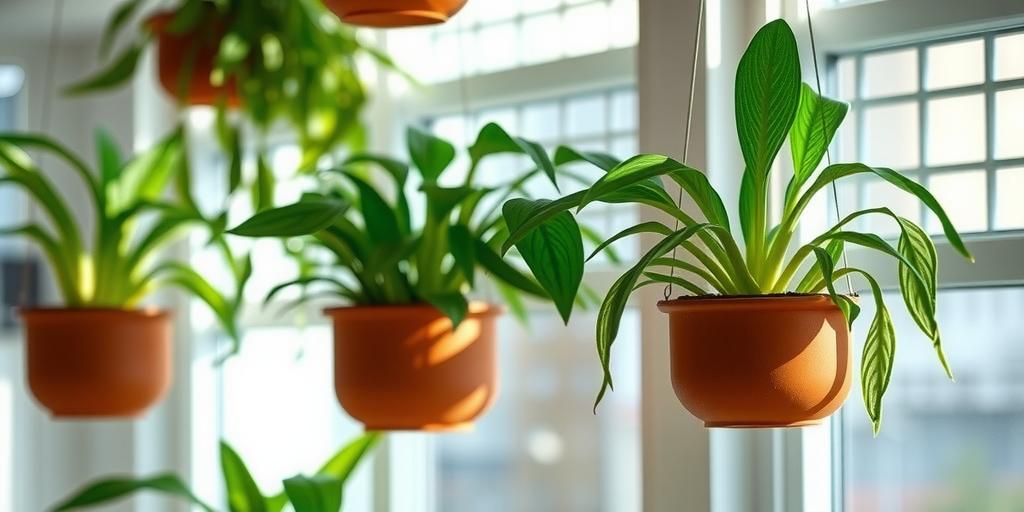
Top Air Purifying Hanging Plants Perfect for Low Light Rooms
Discover the best air-purifying hanging plants for low-light rooms! These easy-care plants improve indoor air quality while adding greenery to dim spaces. Perfect for homes and offices!
Introduction
Did you know indoor air can be up to 5 times more polluted than outdoor air? Luckily, nature has a solution—air-purifying plants! If you have low-light rooms but still want to enjoy cleaner air and lush greenery, hanging plants are the perfect choice. They save space, thrive in indirect light, and filter toxins like formaldehyde and benzene. In this guide, we’ll explore the best air-purifying hanging plants that flourish even in dim corners. Let’s dive in!
Why Choose Hanging Plants for Low Light?
Hanging plants are a fantastic choice for anyone looking to bring greenery into their home without sacrificing space. Whether you live in a small apartment or just want to maximize your room’s layout, hanging plants allow you to add life to your space without cluttering surfaces. Plus, they create a stunning visual effect with their cascading vines and lush foliage.
Another major perk? Many hanging plants thrive in low-light conditions, making them ideal for rooms with minimal natural sunlight. Unlike sun-loving plants that require constant bright light, these varieties adapt well to dimmer spaces, such as north-facing windows or rooms with artificial lighting.
Beyond aesthetics, hanging plants also improve indoor air quality by filtering out common toxins like formaldehyde, benzene, and xylene. They act as natural air purifiers, making your home not only more beautiful but also healthier.
Best Air-Purifying Hanging Plants for Low Light
If you’re looking for the best low-light hanging plants that also purify the air, here are five top picks that are both easy to care for and effective at cleaning your indoor environment.
1. Spider Plant (Chlorophytum comosum)
Spider plants are a favorite among indoor gardeners—and for good reason. They’re incredibly resilient and excel at removing toxins like formaldehyde, xylene, and even carbon monoxide from the air.
One of their best features? They thrive in low light, though they’ll grow faster if given bright, indirect sunlight. If you’re new to plant care, this is a great starter plant because it’s forgiving and low-maintenance.
Another fun perk? Spider plants produce “pups”—tiny offshoots that dangle from the mother plant. These can be easily propagated to grow new plants, making them a budget-friendly option for expanding your indoor jungle.
2. Pothos (Epipremnum aureum)
Pothos, also known as Devil’s Ivy, is another excellent choice for low-light spaces. It’s particularly effective at filtering benzene, formaldehyde, and xylene from the air.
This plant is nearly indestructible, making it perfect for forgetful waterers. It can tolerate drought and still bounce back, though it prefers its soil to dry out slightly between waterings.
Pothos comes in several eye-catching varieties, including Golden Pothos (with yellow variegation) and Marble Queen (with creamy white streaks). Its long, trailing vines make it a gorgeous addition to hanging baskets, shelves, or high ledges.
3. English Ivy (Hedera helix)
English Ivy isn’t just a pretty plant—it’s a powerhouse when it comes to air purification. Studies have shown it can reduce airborne mold and filter out toxins, making it a great choice for improving indoor air quality.
While it prefers indirect light, it can adapt to low-light conditions, though its growth may slow down. The vines create a lush, cascading effect, perfect for adding a touch of elegance to any room.
One thing to keep in mind: English Ivy benefits from occasional pruning to keep its shape in check. Otherwise, it can become a bit unruly over time.
4. Philodendron Heartleaf (Philodendron hederaceum)
With its charming heart-shaped leaves, the Heartleaf Philodendron is a popular choice for hanging planters. It’s particularly good at removing volatile organic compounds (VOCs) from the air, making it a great natural air purifier.
This plant thrives in low to medium light and is incredibly low-maintenance. It grows quickly, so you’ll see noticeable progress in its trailing vines over time. Just be sure to let the soil dry out between waterings to avoid root rot.
5. Boston Fern (Nephrolepis exaltata)
Boston Ferns are known for their lush, feathery fronds and their ability to act as natural humidifiers. They also do an excellent job of filtering indoor air pollutants.
While they prefer indirect light, they can adapt to lower-light conditions, especially in humid environments like bathrooms. They do require consistent watering—keeping the soil slightly moist is key—but their vibrant foliage makes the extra care worth it.
Care Tips for Hanging Plants in Low Light
Even though these plants are low-light tolerant, they still need proper care to thrive. Here are some essential tips to keep them healthy:
-
Water sparingly. Since low-light conditions slow down soil drying, overwatering is a common issue. Always check the soil moisture before watering—stick your finger about an inch deep; if it feels dry, it’s time to water.
-
Rotate occasionally. To ensure even growth, rotate your hanging plants every few weeks so all sides receive some light exposure.
-
Wipe the leaves. Dust can accumulate on leaves, blocking light absorption. Gently wipe them with a damp cloth to keep them clean and efficient at photosynthesis.
-
Avoid over-fertilizing. Low-light plants grow slower, so they don’t need as much fertilizer. A diluted, balanced fertilizer every few months is usually sufficient.
-
Use well-draining soil. To prevent root rot, opt for a potting mix that allows excess water to drain easily. Adding perlite or orchid bark can improve drainage.
By following these simple care guidelines, your hanging plants will stay lush and vibrant, even in low-light spaces. Whether you choose a Spider Plant for its easy propagation or a Boston Fern for its air-purifying benefits, these plants will bring life and beauty to your home with minimal effort.
Conclusion
Who says low-light rooms can’t be green and fresh? With these air-purifying hanging plants, you can enjoy cleaner air and vibrant foliage—even in the dimmest corners. Whether you choose a hardy Spider Plant or a cascading Pothos, these plants are low-maintenance and effective at filtering toxins. Ready to transform your space? Pick your favorite and start hanging!
